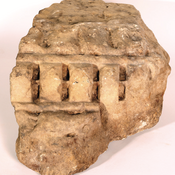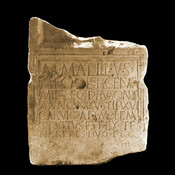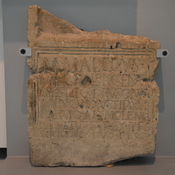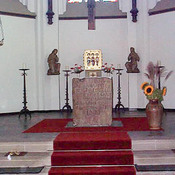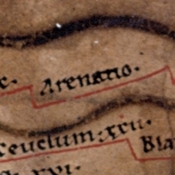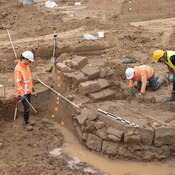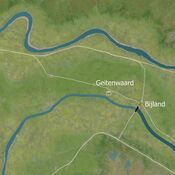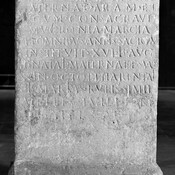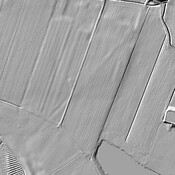The first Roman site along the Rhine in the Netherlands is near Spijk. The site was recognized as a Roman site in 2016 by W. Kuijpers. In the spring of 2021, the work will be completed and the area will be ready to be used as a nature reserve. A publication is in preparation. This site lies about 3 km east of the castellum near Herwen. 5 km to the south in Germany is the Roman site of Rindern. The site is close to the moraine near Elten. Here the Rhine still has a fairly high flow velocity when it enters the Netherlands. Both early and late Roman finds have been recovered from this site. Most of the pottery shows signs of displacement: the edges of many pieces have been rounded off considerably. The large quantity of pottery and fragments of coarse ceramics point to the presence of a Roman complex, inhabited for several centuries. There were several stone buildings, at least one of which had a hypocaust. The coarse ceramics also demonstrate the presence of a military component in the find complex. The displaced finds could have come from a castellum located further upstream. Probably the Roman castellum at the junction of the Rhine and Waal rivers which must have been near there.
Chapter 3 of the recently published book 'Het Romeinse castellum in de Loowaard' presents a new hypothesis of the situation around the fork in the Rhine and Waal in Roman times. This is because the assumed location of the junction at the Drusus Dam near Herwen-De Bijland proves untenable due to hydraulic arguments (Zijlmans, 2016) and the archaeological findings in Spijk. The construction of a cut-off dam at Herwen would create a large stretch of river with virtually stagnant water between the Rhine-Waal fork at Spijk and the dam at Herwen. This large expanse of water corresponds to Tacitus' description of Germanicus' gathering place for his 'thousand vessels'. These were assembled in 13-16 AD for his punitive expeditions in Germania in the aftermath of the Varus Battle. The calm waters and the space offer every opportunity to build up such a fleet.
A remarkable find of this site is the ridge of a late Roman Intercisa helmet. It can be seen here and more in detail on the website of Portable Antiquities of the Netherlands, PAN-number: PAN-00083452.
Literature:
Kuijpers, W., 2021, 29-30. Het Romeinse castellum in de Loowaard. Een hernieuwde materiaalstudie en interpretatie van baggervondsten uit Duiven-Loowaard. Pumbo.nl.
(With an extensive English summary and more than 450 full-colour photographs of Roman artefacts)
Kuijpers, W., 2021. Detector Magazine, mei 2021, 26-34. De verspoelde Romeinse vindplaatsen in de Gelderse limes. (English)
De eerste Romeinse vindplaats langs de Rijn in ons land is bij Spijk. Deze vindplaats ligt ca. 3 km ten oosten van het castellum bij Herwen. De locatie ligt dicht bij de stuwwal bij Elten. De vindplaats werd in 2016 onderkend als Romeinse vindplaats door W. Kuijpers. In het voorjaar van 2021 zijn de werkzaamheden afgesloten en is het gebied gereed gemaakt voor natuurgebied. Uit deze vindplaats komen zowel vroege- als laat Romeinse vondsten tevoorschijn. Hier heeft de Rijn bij binnenkomst in ons land nog een redelijk hoge stroomsnelheid. Het grootste gedeelte van het aardewerk vertoont tekenen van verplaatsing: van veel stukken zijn de randen flink afgerond. De grote hoeveelheid aardewerk en fragmenten grofkeramiek wijzen op de aanwezigheid van een Romeins complex, bewoont gedurende meerdere eeuwen. Er waren over een langere periode verschillende stenen gebouwen aanwezig waarvan minstens een gebouw met een hypocaustum. Het grofkeramiek toont ook aan dat er een militaire component aanwezig is in het vondstcomplex. De verspoelde vondsten zouden afkomstig kunnen zijn van het castellum dat de splitsing van de Rijn en de Waal bewaakte. Dit fort moet in de buurt hebben gelegen.
In Hoofdstuk 3 van het onlangs verschenen boek ‘Het Romeinse castellum in de Loowaard’ staat een verbeelding van een nieuwe hypothese van de situatie rond de splitsing van Rijn en Waal in de Romeinse tijd. Dit omdat de veronderstelde locatie van de splitsing bij de Drususdam bij Herwen-De Bijland niet houdbaar blijkt vanwege waterbouwkundige argumenten (Zijlmans, 2016) en de archeologische bevindingen in Spijk. Door het leggen van een afsluitende dam bij Herwen ontstaat er tussen de Rijn-Waalsplitsing bij Spijk en de dam bij Herwen een groot stuk rivier met vrijwel stilstaand water. Deze grote watervlakte komt overeen met de beschrijving die Tacitus gaf van de verzamelplaats van Germanicus voor zijn ‘duizend vaartuigen’. Deze worden in 13-16 na Chr. bijeengebracht voor zijn strafexpedities in Germanië in de nasleep van de Varus-nederlaag. Het rustige vaarwater en de ruimte biedt alle gelegenheid tot opbouw van een dergelijke vloot.
Een opmerkelijke vondst uit Spijk is een laat Romeinse Intercisahelm. (zie afbeelding) Deze is meer in detail te zien op de website van Portable Antiquities of the Netherlands onder PAN-nummer: PAN-00083452. Een publicatie over de vindplaats en het vondstmateriaal is in voorbereiding.
Literatuur



